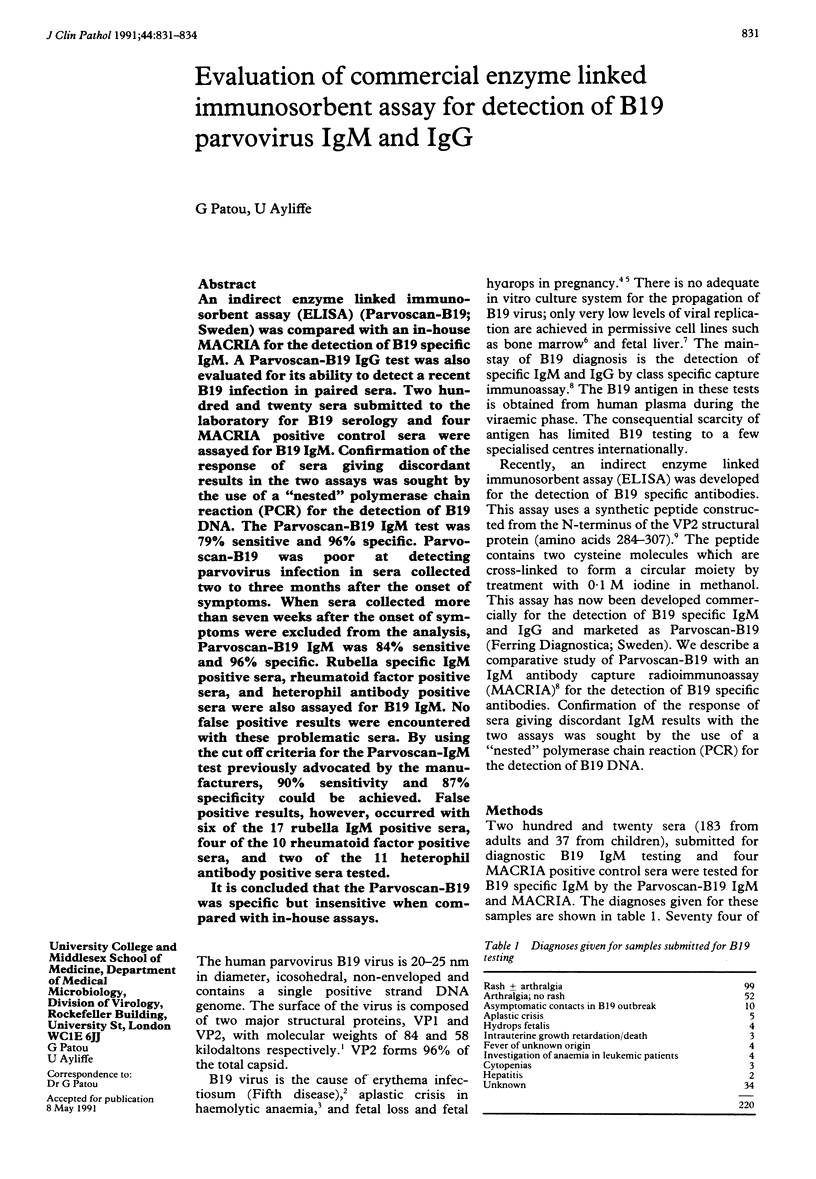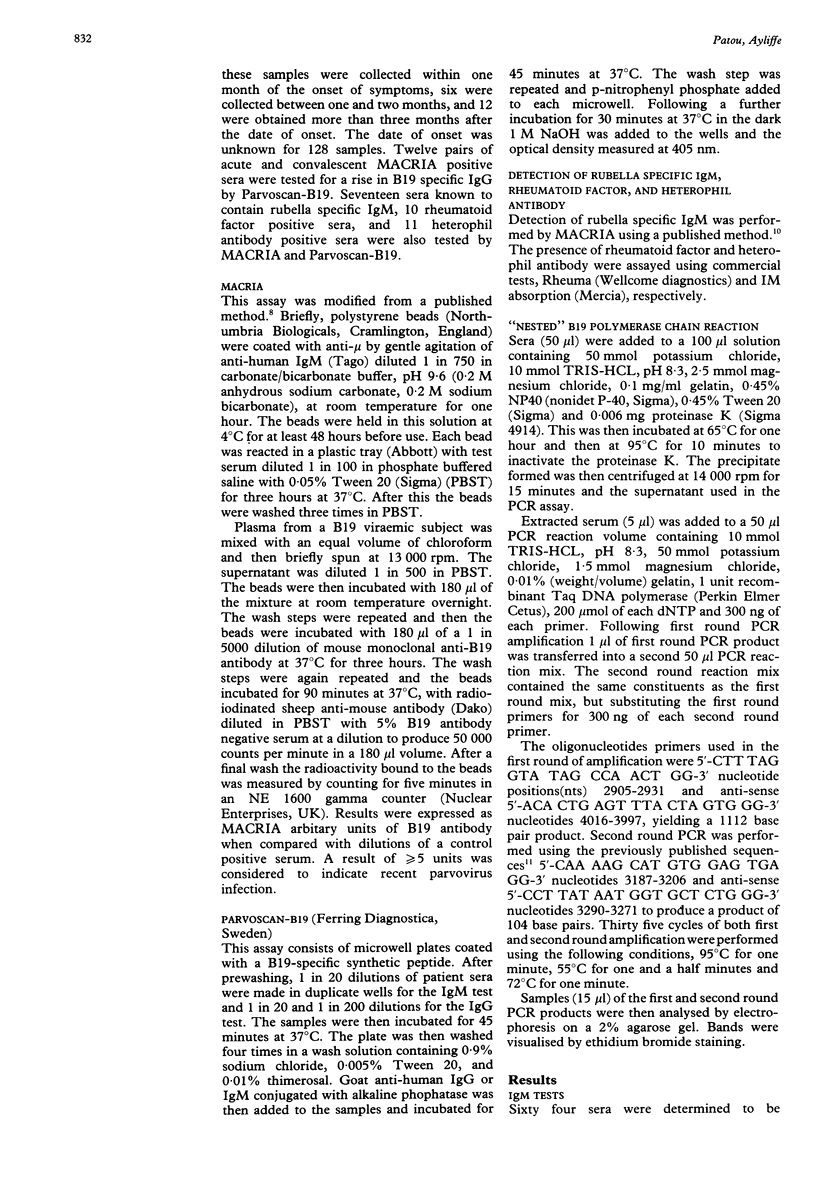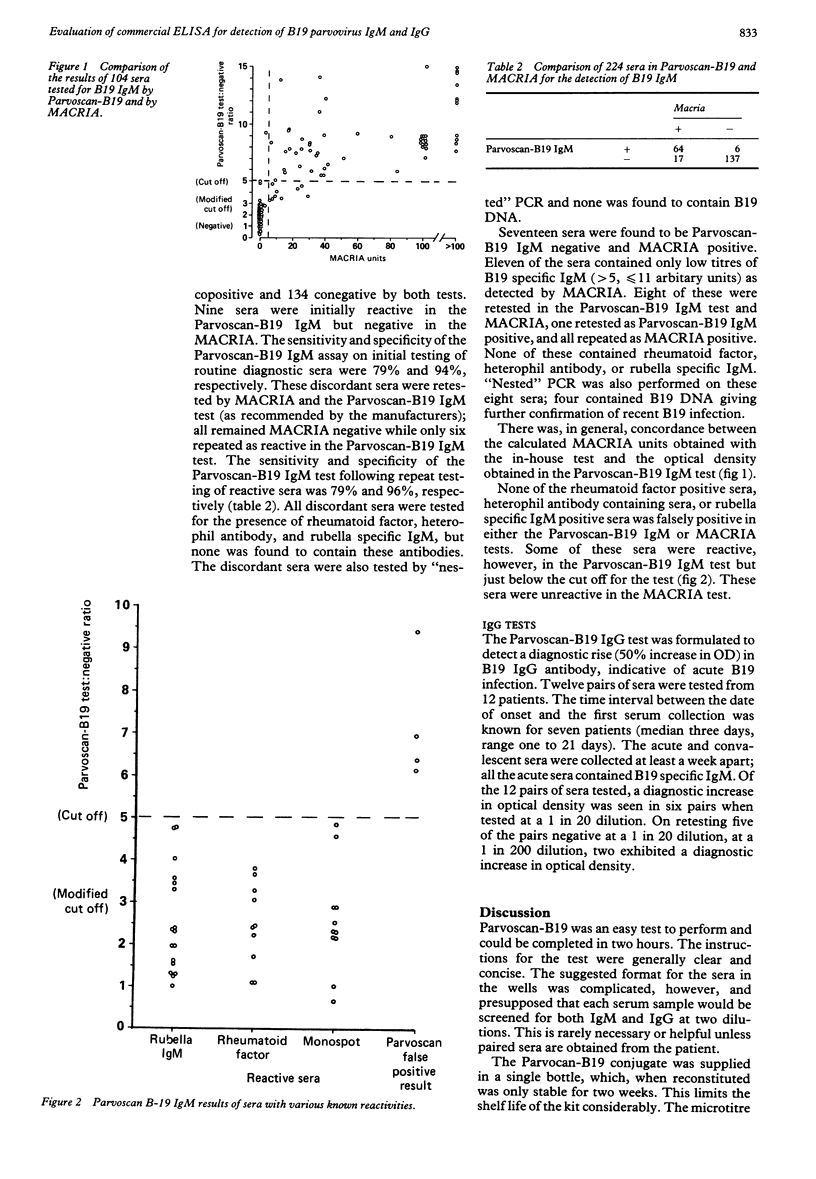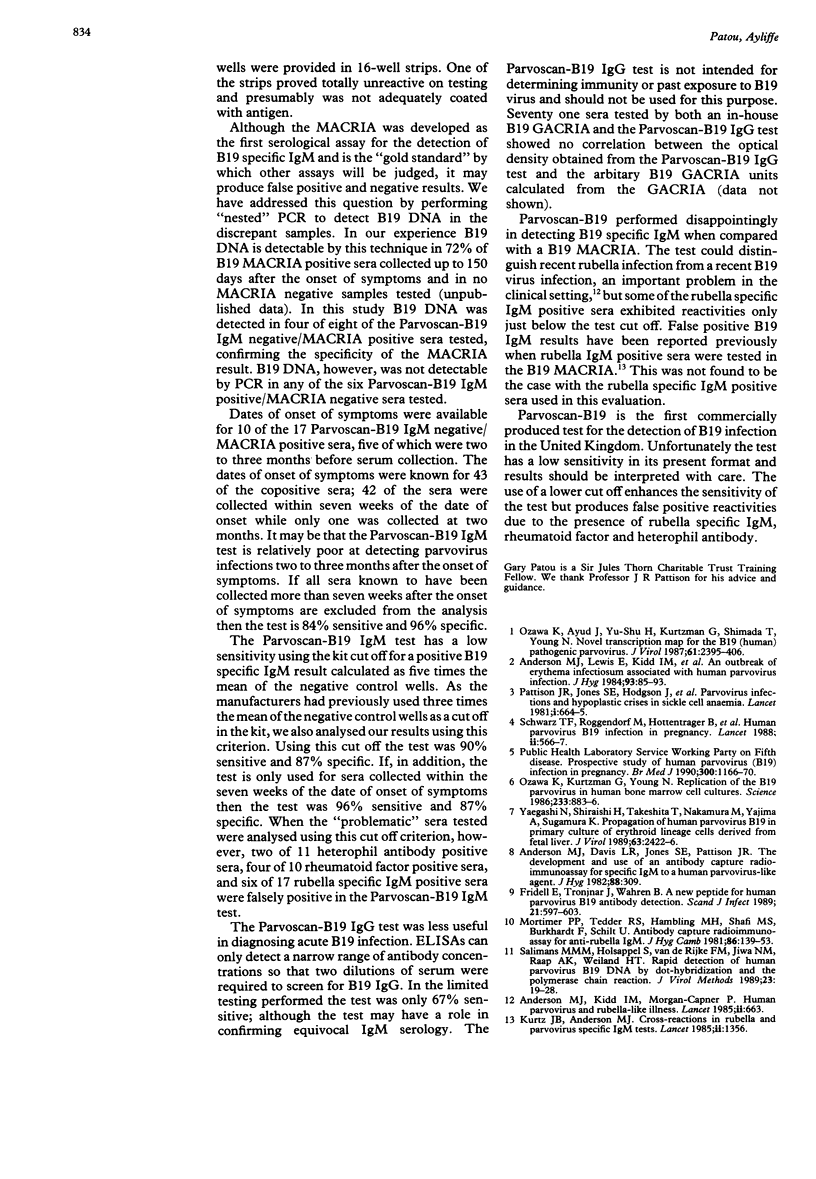Abstract
An indirect enzyme linked immunosorbent assay (ELISA) (Parvoscan-B19; Sweden) was compared with an in-house MACRIA for the detection of B19 specific IgM. A Parvoscan-B19 IgG test was also evaluated for its ability to detect a recent B19 infection in paired sera. Two hundred and twenty sera submitted to the laboratory for B19 serology and four MACRIA positive control sera were assayed for B19 IgM. Confirmation of the response of sera giving discordant results in the two assays was sought by the use of a "nested" polymerase chain reaction (PCR) for the detection of B19 DNA. The Parvoscan-B19 IgM test was 79% sensitive and 96% specific. Parvoscan-B19 was poor at detecting parvovirus infection in sera collected two to three months after the onset of symptoms. When sera collected more than seven weeks after the onset of symptoms were excluded from the analysis, Parvoscan-B19 IgM was 84% sensitive and 96% specific. Rubella specific IgM positive sera, rheumatoid factor positive sera, and heterophil antibody positive sera were also assayed for B19 IgM. No false positive results were encountered with these problematic sera. By using the cut off criteria for the Parvoscan-IgM test previously advocated by the manufacturers, 90% sensitivity and 87% specificity could be achieved. False positive results, however, occurred with six of the 17 rubella IgM positive sera, four of the 10 rheumatoid factor positive sera, and two of the 11 heterophil antibody positive sera tested. It is concluded that the Parvoscan-B19 was specific but insensitive when compared with in-house assays.
Full text
PDF



Selected References
These references are in PubMed. This may not be the complete list of references from this article.
- Anderson M. J., Davis L. R., Jones S. E., Pattison J. R., Serjeant G. R. The development and use of an antibody capture radioimmunoassay for specific IgM to a human parvovirus-like agent. J Hyg (Lond) 1982 Apr;88(2):309–324. doi: 10.1017/s0022172400070169. [DOI] [PMC free article] [PubMed] [Google Scholar]
- Anderson M. J., Kidd I. M., Morgan-Capner P. Human parvovirus and rubella-like illness. Lancet. 1985 Sep 21;2(8456):663–663. doi: 10.1016/s0140-6736(85)90025-x. [DOI] [PubMed] [Google Scholar]
- Anderson M. J., Lewis E., Kidd I. M., Hall S. M., Cohen B. J. An outbreak of erythema infectiosum associated with human parvovirus infection. J Hyg (Lond) 1984 Aug;93(1):85–93. doi: 10.1017/s0022172400060964. [DOI] [PMC free article] [PubMed] [Google Scholar]
- Fridell E., Trojnar J., Wahren B. A new peptide for human parvovirus B19 antibody detection. Scand J Infect Dis. 1989;21(6):597–603. doi: 10.3109/00365548909021686. [DOI] [PubMed] [Google Scholar]
- Kurtz J. B., Anderson M. J. Cross-reactions in rubella and parvovirus specific IgM tests. Lancet. 1985 Dec 14;2(8468):1356–1356. doi: 10.1016/s0140-6736(85)92647-9. [DOI] [PubMed] [Google Scholar]
- Mortimer P. P., Tedder R. S., Hamblig M. H., Shafi M. S., Burkhardt F., Schilt U. Antibody capture radioimmunoassay for anti-rubella IgM. J Hyg (Lond) 1981 Apr;86(2):139–153. doi: 10.1017/s0022172400068856. [DOI] [PMC free article] [PubMed] [Google Scholar]
- Ozawa K., Ayub J., Hao Y. S., Kurtzman G., Shimada T., Young N. Novel transcription map for the B19 (human) pathogenic parvovirus. J Virol. 1987 Aug;61(8):2395–2406. doi: 10.1128/jvi.61.8.2395-2406.1987. [DOI] [PMC free article] [PubMed] [Google Scholar]
- Ozawa K., Kurtzman G., Young N. Replication of the B19 parvovirus in human bone marrow cell cultures. Science. 1986 Aug 22;233(4766):883–886. doi: 10.1126/science.3738514. [DOI] [PubMed] [Google Scholar]
- Pattison J. R., Jones S. E., Hodgson J., Davis L. R., White J. M., Stroud C. E., Murtaza L. Parvovirus infections and hypoplastic crisis in sickle-cell anaemia. Lancet. 1981 Mar 21;1(8221):664–665. doi: 10.1016/s0140-6736(81)91579-8. [DOI] [PubMed] [Google Scholar]
- Salimans M. M., Holsappel S., van de Rijke F. M., Jiwa N. M., Raap A. K., Weiland H. T. Rapid detection of human parvovirus B19 DNA by dot-hybridization and the polymerase chain reaction. J Virol Methods. 1989 Jan;23(1):19–28. doi: 10.1016/0166-0934(89)90085-2. [DOI] [PubMed] [Google Scholar]
- Schwarz T. F., Roggendorf M., Hottenträger B., Deinhardt F., Enders G., Gloning K. P., Schramm T., Hansmann M. Human parvovirus B19 infection in pregnancy. Lancet. 1988 Sep 3;2(8610):566–567. doi: 10.1016/s0140-6736(88)92684-0. [DOI] [PubMed] [Google Scholar]
- Yaegashi N., Shiraishi H., Takeshita T., Nakamura M., Yajima A., Sugamura K. Propagation of human parvovirus B19 in primary culture of erythroid lineage cells derived from fetal liver. J Virol. 1989 Jun;63(6):2422–2426. doi: 10.1128/jvi.63.6.2422-2426.1989. [DOI] [PMC free article] [PubMed] [Google Scholar]


